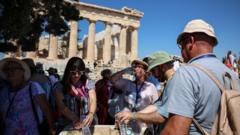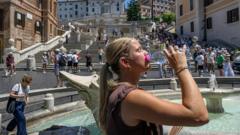In the holy city of Mecca, more than 1.4 million Muslims have commenced the sacred Hajj pilgrimage, with severe heat conditions anticipated, prompting a host of safety measures from Saudi officials. They have developed guidelines urging pilgrims to adhere to precautions to combat the raging temperatures, with forecasts estimating highs reaching 44°C (111°F).
**Saudi Arabia Intensifies Heat Safety Measures Amid Hajj Pilgrimage Amid Concerns of Last Year's Fatalities**

**Saudi Arabia Intensifies Heat Safety Measures Amid Hajj Pilgrimage Amid Concerns of Last Year's Fatalities**
Saudi authorities are doubling down on initiatives to ensure the safety of pilgrims during this year's Hajj, following a devastating heatwave that claimed over 1,300 lives last year.
In an effort to prevent a repeat of last year's tragedy, where an overwhelming majority of fatalities were associated with unregistered pilgrims lacking adequate accommodations and amenities, authorities have imposed a ban on children under 12 from participating. The government is actively enforcing regulations, having already prevented over 269,000 individuals from entering the city without legitimate permits, which could result in steep fines of up to $5,000 and a decade-long entry ban.
This year, Saudi Arabia has enhanced safety measures by planting thousands of trees and installing hundreds of cooling units throughout Mecca. Reports indicate that the Grand Mosque features the world's largest cooling system, while shaded areas have been expanded by 50,000 square meters to provide relief from the sun. Pilgrims are being advised to avoid sun exposure during peak hours, utilize umbrellas, and remain hydrated in an effort to fend off heat-related illnesses.
The Hajj represents one of Islam's five fundamental Pillars and is an obligatory spiritual journey for devout Muslims capable of undertaking it. After arriving dressed in the traditional garments symbolizing purity, pilgrims will participate in various rituals, including the tawaf—circling the Kaaba—and traversing between the hills of Safa and Marwa.
As the pilgrimage continues, the Saudi health ministry remains vigilant, utilizing innovative technology, including artificial intelligence and drones, to oversee crowd management and ensure the well-being of those undertaking this significant spiritual endeavor. Amid past calamities, the focus on safety and preventive measures illustrates Saudi Arabia's commitment to protecting pilgrims during one of the most important religious events of the year.
This year, Saudi Arabia has enhanced safety measures by planting thousands of trees and installing hundreds of cooling units throughout Mecca. Reports indicate that the Grand Mosque features the world's largest cooling system, while shaded areas have been expanded by 50,000 square meters to provide relief from the sun. Pilgrims are being advised to avoid sun exposure during peak hours, utilize umbrellas, and remain hydrated in an effort to fend off heat-related illnesses.
The Hajj represents one of Islam's five fundamental Pillars and is an obligatory spiritual journey for devout Muslims capable of undertaking it. After arriving dressed in the traditional garments symbolizing purity, pilgrims will participate in various rituals, including the tawaf—circling the Kaaba—and traversing between the hills of Safa and Marwa.
As the pilgrimage continues, the Saudi health ministry remains vigilant, utilizing innovative technology, including artificial intelligence and drones, to oversee crowd management and ensure the well-being of those undertaking this significant spiritual endeavor. Amid past calamities, the focus on safety and preventive measures illustrates Saudi Arabia's commitment to protecting pilgrims during one of the most important religious events of the year.





















